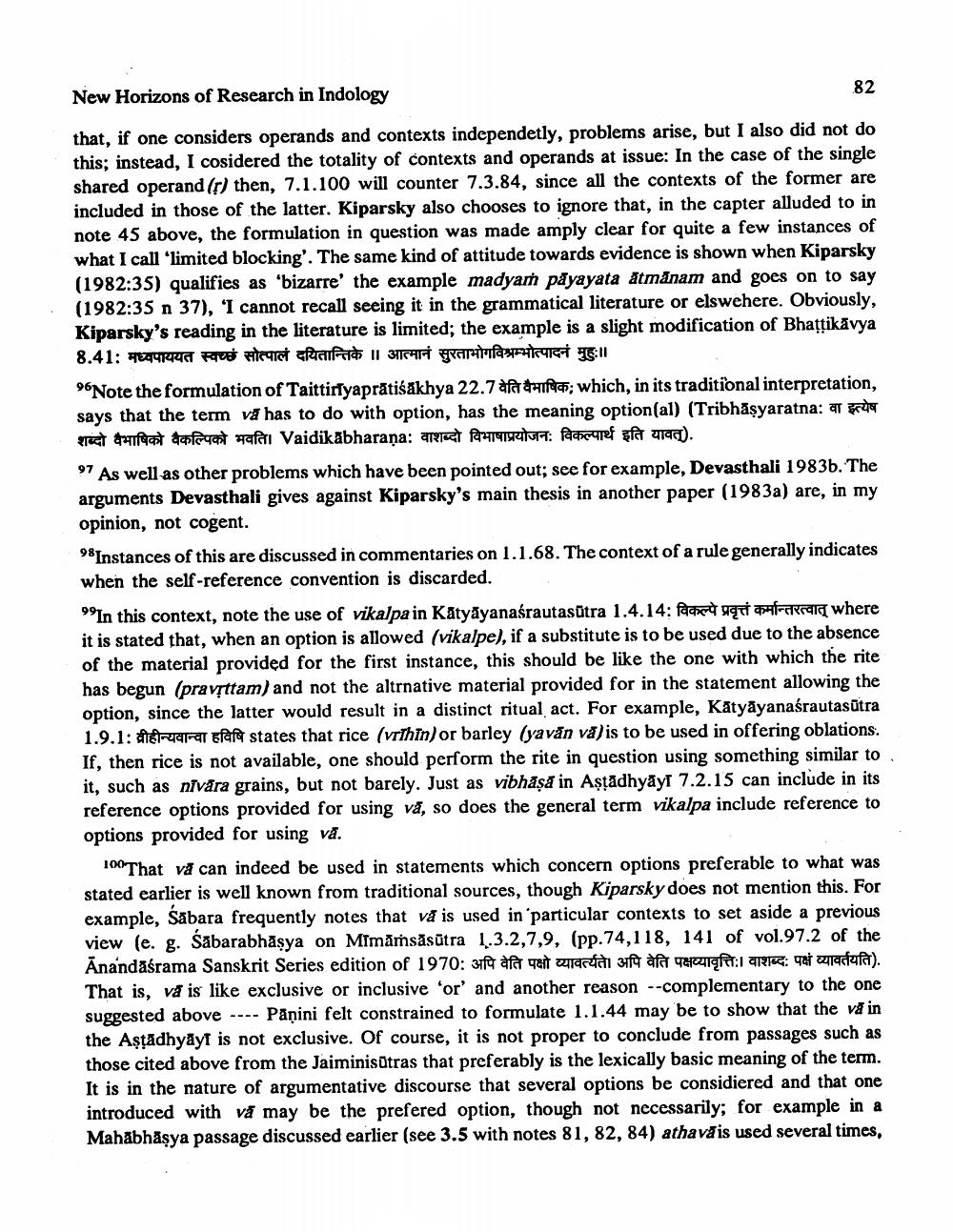________________
New Horizons of Research in Indology
82
that, if one considers operands and contexts independetly, problems arise, but I also did not do this; instead, I cosidered the totality of contexts and operands at issue: In the case of the single shared operand (r) then, 7.1.100 will counter 7.3.84, since all the contexts of the former are included in those of the latter. Kiparsky also chooses to ignore that, in the capter alluded to in note 45 above, the formulation in question was made amply clear for quite a few instances of what I call 'limited blocking'. The same kind of attitude towards evidence is shown when Kiparsky (1982:35) qualifies as 'bizarre' the example madyam pāyayata atmanam and goes on to say (1982:35 n 37), 'I cannot recall seeing it in the grammatical literature or elswehere. Obviously, Kiparsky's reading in the literature is limited; the example is a slight modification of Bhattikävya 8.41: HAURRET FTOS Ateaict sprato il 31164rt grarutyanici Il 9Note the formulation of Taittirfyaprātisakhya 22.7 afarh4; which, in its traditional interpretation, says that the term và has to do with option, has the meaning option(al) (Tribhāşyaratna: a stast
a t afect wafari Vaidikābharaṇa: arrat PANUTA: Peref sfa 1190). 97 As well as other problems which have been pointed out; see for example, Devasthali 19836. The arguments Devasthali gives against Kiparsky's main thesis in another paper (1983a) are, in my opinion, not cogent. 98Instances of this are discussed in commentaries on 1.1.68. The context of a rule generally indicates when the self-reference convention is discarded. 9'In this context, note the use of vikalpa in Katyāyanaśrautasūtra 1.4.14: Pater geti suferais where it is stated that, when an option is allowed (vikalpe), if a substitute is to be used due to the absence of the material provided for the first instance, this should be like the one with which the rite has begun (pravịttam) and not the altrnative material provided for in the statement allowing the option, since the latter would result in a distinct ritual act. For example, Katyāyanaśrautasūtra 1.9.1:
d a ar af states that rice (vrthin) or barley (yavăn vă) is to be used in offering oblations. If, then rice is not available, one should perform the rite in question using something similar to it, such as nīvāra grains, but not barely. Just as vibhāşă in Aştadhyāyf 7.2.15 can include in its reference options provided for using vă, so does the general term vikalpa include reference to options provided for using vă.
100 That và can indeed be used in statements which concern options preferable to what was stated earlier is well known from traditional sources, though Kiparsky does not mention this. For example, Sábara frequently notes that va is used in particular contexts to set aside a previous view (e. g. Sabarabhāsya on Mimāṁsāsūtra 1.3.2,7,9, (pp. 74,118, 141 of vol.97.2 of the Ānandāśrama Sanskrit Series edition of 1970: 3f afar wat onartai sufo ata quella:1 ARK: na andefat). That is, va is like exclusive or inclusive 'or' and another reason --complementary to the one suggested above ---- Pāṇini felt constrained to formulate 1.1.44 may be to show that the va in the Așțădhyāyf is not exclusive. Of course, it is not proper to conclude from passages such as those cited above from the Jaiminisūtras that preferably is the lexically basic meaning of the term. It is in the nature of argumentative discourse that several options be considiered and that one introduced with vă may be the prefered option, though not necessarily; for example in a Mahābhāşya passage discussed earlier (see 3.5 with notes 81, 82, 84) athavă is used several times,




